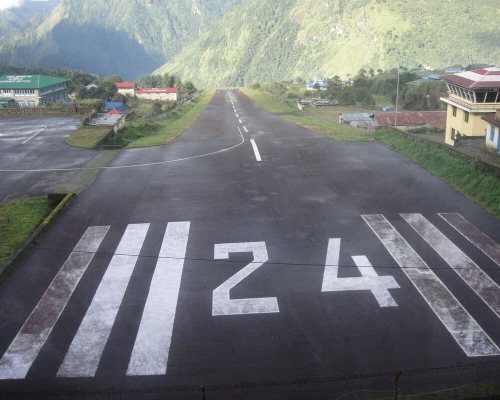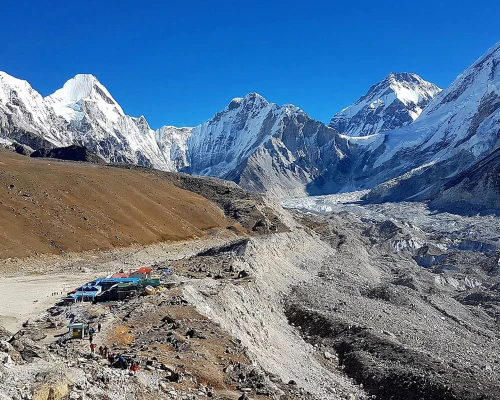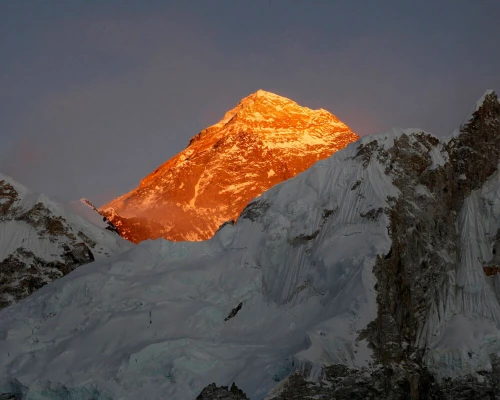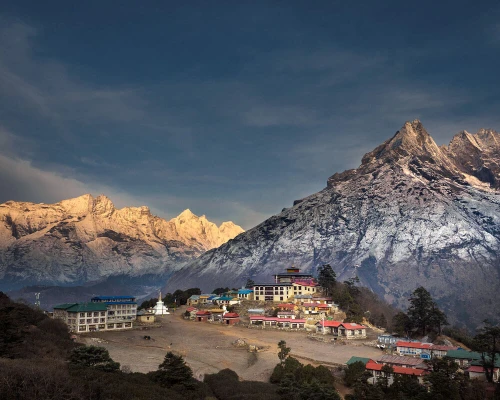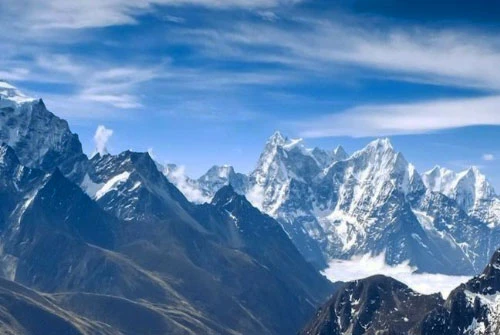Seasons In Everest Region
Everest region, nestled in the heart of the Himalayas, experiences distinct climatic variations throughout the year, giving rise to four distinct seasons: spring, summer, autumn, and winter. Each season presents a unique set of challenges and opportunities for those seeking to trek through this awe-inspiring landscape.
Spring: The Blossoming Season
As the harsh grip of winter loosens its hold, the Everest Region awakens to a symphony of colours and life. Spring, spanning the months of March, April, and May, emerges as the peak season for trekking, drawing adventurers from all corners of the globe to witness the region's stunning transformation.
The days are kissed by the warmth of the sun, with temperatures ranging from a comfortable 15°C to a crisp -10°C at higher elevations. The air is crisp and invigorating, carrying the sweet scent of blooming rhododendrons, the region's national flower. These vibrant blossoms paint the hillsides in hues of pink, red, and purple, creating a breathtaking spectacle.

The skies, once shrouded in winter's gloom, now reveal themselves in their pristine glory. The clouds parted, allowing for unobstructed views of the majestic peaks, their snow-capped summits piercing the cerulean expanse. The sun's rays dance upon the glistening ice and snow, casting an ethereal glow upon the landscape.
The trails, once hardened by winter's frost, soften and become more comfortable to traverse. The air is drier, making breathing easier at high altitudes. The absence of monsoon rains ensures that the paths are free from mud and landslides, making the trekking experience smoother and safer.
Despite its allure, spring also presents a few challenges for trekkers. Occasional snowfall can still occur, especially at higher altitudes, requiring trekkers to be prepared for unpredictable weather conditions. Additionally, the popularity of the season brings larger crowds, which can sometimes diminish the sense of solitude and serenity that many trekkers seek.
Autumn: A Serene Rendezvous
As the vibrant hues of summer gradually fade and the world prepares for winter's embrace, a hidden gem emerges in the Everest Region – autumn. This enchanting season unveils a tranquil escape from the throngs of spring, offering a harmonious blend of stable weather, breathtaking mountain vistas, and a sense of serenity that permeates the very air.
For those seeking an escape from the crowds and a more intimate encounter with the majestic Himalayas, autumn presents an ideal opportunity. The trails, once teeming with fellow adventurers, now beckon with a promise of solitude and introspection. The crisp mountain air invigorates the senses, while the absence of summer's haze unveils the jagged peaks in all their glory.
As the autumn chill descends upon the region, temperatures moderate, ranging from a comfortable 12°C during the day to a crisp -1°C at night.While autumn bestows its blessings, it also demands respect. The temperatures descend, ushering in a cool, crisp embrace.
Occasional snowfall paints the landscape a pristine white, transforming the trails into a winter wonderland. These picturesque scenes, however, serve as a reminder that proper preparation is essential. Warm clothing, sturdy footwear, and a cautious approach are paramount to ensuring a safe and enjoyable trekking experience.

Autumn's tranquilly extends beyond the physical realm, seeping into the very essence of the trekking experience. The absence of crowds allows for a deeper connection with the surrounding wilderness. The crunch of footsteps on dry leaves, the gentle murmur of a cascading stream, the symphony of birdsong—these subtle sounds become amplified, creating a symphony of nature that resonates with the soul.
As the sun dips below the horizon, casting long shadows across the snow-dusted peaks, a sense of tranquilly descends upon the Everest Region. The stars emerge, twinkling like diamonds against the inky expanse of the night sky, their brilliance heightened by the absence of city lights. The silence is profound, broken only by the occasional howl of a distant wolf, a reminder of the wildness that surrounds.
Autumn in the Everest Region is not merely a season; it is an invitation to slow down, to breathe deeply, and to immerse oneself in the grandeur of nature's embrace. It is a time to shed the hustle and bustle of daily life and reconnect with the serenity that lies within.
Summer: Embracing the Monsoon
While the Everest Region is typically associated with the allure of spring and autumn trekking, the summer season, often characterized by the monsoon, offers a unique and distinct experience. While it may not be the ideal time for traditional trekking, the summer presents an opportunity for cultural immersion, exploration of lower-altitude trails, and a deeper appreciation for the region's natural beauty.
Before delving into the summer's offerings, it's crucial to acknowledge the potential challenges associated with trekking during the monsoon season. Heavy rainfall, landslides, and potential trail closures can significantly impact the trekking experience. It is essential to exercise caution, carefully monitor weather conditions, and be prepared for potential interruptions or changes in the itinerary.
Despite the monsoon's reputation for heavy rains, the summer in the Everest Region is surprisingly temperate. Temperatures typically range from 15°C to 25°C, making the days pleasantly warm and comfortable. The lush greenery and vibrant flora, nourished by the monsoon rains, add a touch of enchantment to the landscape.

While trekking to higher altitudes during the monsoon may not be advisable, the summer offers an opportunity for cultural immersion and exploration of lower-altitude trails. The lower valleys and villages remain relatively unaffected by the monsoon, providing a chance to experience the region's rich culture, interact with locals, and delve into their traditions.
The summer monsoon, though challenging for trekking, plays a vital role in the region's ecosystem. The abundant rainfall replenishes water sources, nourishes the vegetation, and sustains the region's diverse wildlife. Witnessing the transformative power of the monsoon fosters a deeper appreciation for nature's cycles and the delicate balance of the ecosystem.
Winter: A Realm of Snow and Solitude
As the Everest Region slumbers under a thick blanket of snow, a unique opportunity unfolds for experienced trekkers seeking a challenge unlike any other. Winter trekking in this pristine wilderness is not for the faint of heart; it's a journey into a realm of snow-capped peaks, frozen landscapes, and an unparalleled sense of solitude.
The allure of winter trekking lies in its stark contrast to the bustling peak seasons. The trails, usually teeming with fellow adventurers, fall silent, giving way to the hushed whispers of the wind and the crunch of snow beneath one's boots. The winter sun's golden rays paint a canvas on which the stark contrast of snow against the towering peaks replaces the crowds.
However, the tranquilly of winter comes with its own set of challenges. The extreme cold, with temperatures plummeting to as low as -20°C, demands specialized equipment, from down jackets and insulated boots to thermal layers and headwear. The frozen trails, often slick with ice, require a steady gait and mountaineering skills.

Physical fitness is paramount for winter trekking. The thin air at high altitudes, coupled with the exertion of navigating snow-covered terrain, demands a well-conditioned body. Proper acclimatization is essential to avoid altitude sickness, and a measured pace is crucial to conserve energy in frigid conditions.
For those who embrace the challenge, winter trekking in the Everest Region offers an unforgettable experience. The solitude provides an opportunity for deep introspection, and the sense of accomplishment in conquering the harsh elements is unmatched. The frozen landscapes, transformed into a winter wonderland, offer a glimpse into the region's untamed beauty, a stark contrast to the vibrant colors of warmer seasons.
Winter trekking in the Everest Region is not for the novice adventurer. It demands thorough preparation, specialized equipment, and a deep respect for the power of nature. But for those who dare to venture into this realm of snow and solitude, the rewards are unparalleled—a transformative experience that etches itself deep into the soul.
Best Season for Trekking Everest Region
The best season for trekking in the Everest region depends on your personal preferences and trekking experience. However, the most popular seasons are spring (March–May) and autumn (September–November).
Spring (March-May)
Spring is considered the best season for trekking in the Everest region for several reasons. The weather is generally stable and sunny, with warm days and cool nights. The trails are dry and comfortable, and the rhododendrons are in full bloom, adding a splash of color to the landscape. However, spring is also the peak season for trekking in the Everest region, so the trails can be crowded, especially during the shoulder seasons of March and May.
Autumn (September-November)
Autumn is a great alternative to spring for trekking in the Everest region. The weather is still stable, with fewer crowds and cooler temperatures. The skies are often clear, providing excellent views of the mountains. The autumn foliage also adds a touch of color to the landscape. However, the weather can be unpredictable in the autumn, with occasional snowfall and rain.
Ultimately, the best season for trekking in the Everest region depends on your individual preferences. If you are looking for the best weather conditions, spring is the best choice. However, if you prefer fewer crowds and don't mind the cooler temperatures, autumn is a great option.
Everest Trekking Seasons and Features
Season | Best Time | Weather | Temperature Range | Visibility | Crowds | Special Events |
Spring | March to May | Mild days, clear skies | 15°C to 20°C | Excellent | Moderate | Rhododendroblooms |
Summer | June to August | Monsoon rains | 15°C to 25°C | Reduced | Low | Lush green landscapes |
Autumn | September to November | Clear skies and crisp temperatures | 5°C to 15°C | Excellent | High | Festivals: Dashain and Tihar |
Winter | December to February | Cold, occasional snow | -15°C to 5°C | Good | Low | Fewer trekkers, snow-capped peaks |
General Tips for a Successful Everest Region Trek
Trekking in the Everest region demands thorough preparation and strategic planning to ensure a safe and enjoyable experience. Here are key tips to maximize your success in navigating the challenging yet awe-inspiring terrain.
- A gradual ascent to higher altitudes is crucial to acclimating to reduced oxygen levels.
- Allow sufficient time for rest and acclimatization days during the trek.
- Invest in high-quality, weather-appropriate gear and clothing.
- Ensure your footwear is comfortable, waterproof, and suitable for varied terrains.
- Secure teahouse accommodations and necessary permits well in advance, especially during peak seasons.
- Be aware of the required permits, including the Sagarmatha National Park entry permit.
- Consider hiring a local guide for navigation and cultural insights.
- A porter can assist with carrying heavy loads, allowing trekkers to focus on the journey.
- Be mindful of local customs and traditions; respect the cultural sensitivities of the communities you encounter.
- Practice responsible trekking by minimizing environmental impact and adhering to Leave No Trace principles.
Conclusion
Everest Base Camp Travel understands the magic of trekking in the Everest Region. We carefully curate our packages to ensure a seamless and unforgettable experience, catering to every need and preference. From experienced guides to well-equipped lodges, we strive to make your Everest adventure as rewarding as possible.
Embark on your Everest Region trek with confidence, knowing that Everest Base Camp Travel is your trusted partner in exploring the Himalayas. Visit our website, Everest Base Camp Travel, today to browse our comprehensive packages and plan your Everest adventure of a lifetime.








